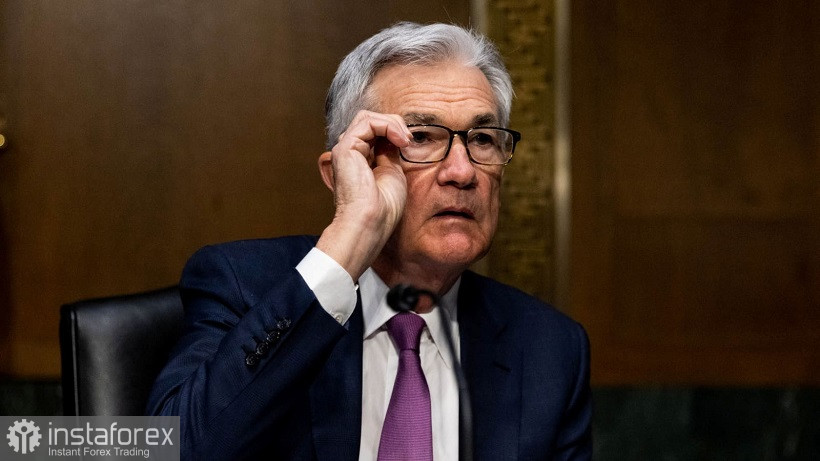This day will determine the fate of dollar pairs at least in the medium term. The Fed will announce the results of its first meeting this year towards the end of the US session on Wednesday. The January meeting will not be a check-through one, given the previous rhetoric of the Fed representatives and the dynamics of key US macroeconomic indicators. Looking ahead, we believe that market expectations are overstated – traders expect too much from the members of the US regulator. However, given the unprecedented pace of US inflation, no options can be ruled out, even the most "hawkish".
It is worth noting that there is currently even a 5% chance of an increase in the interest rate following the results of the January meeting. The probability is minimal, but it suggests that the market expects to hear clear signals from the Fed regarding the pace of monetary policy tightening within the current year. If the messages announced today are vague and/or do not agree with the basic scenario of most analysts, the US dollar will collapse throughout the market. In this case, the "guaranteed" March rate increase will not help the currency either – this fact has already been played back and taken into account in prices.

First of all, traders are interested in the benchmark for raising the rate in 2022. According to the base scenario, four increases are expected this year: in March, in June or August, in November and December. Analysts at Goldman Sachs said that this is very likely. If Jerome Powell agrees with such a "schedule", the US dollar will receive moderate support: the US dollar paired with the euro can settle at 1.12 area and even test the support level of 1.1200.
It can be recalled here that numerous experts began to voice more "hawkish" forecasts before the January meeting, thereby raising the bar of expectations. In particular, currency strategists at Deutsche Bank have warned their clients that the market is underestimating the Fed's hawkishness, which is likely to tackle inflation with all its might in the country. According to the bank's analysts, the American regulator may raise the rate 6 or 7 times by the end of the year, starting from the March meeting. That is, we are talking about the fact that the Fed will tighten monetary policy at almost every meeting.
On the one hand, this forecast looks unlikely. However, one should also take into account the conditions in which the Fed found itself. US inflation is at its highest level in 40 years, and unemployment has fallen from 5.9% to 3.9% in just six months. In recent speeches, Jerome Powell has shifted the focus of his rhetoric to inflation, increasingly pointing out the need to resist its steady rise. Back in November last year, the Fed chairman admitted that it was time to stop calling inflation "temporary." Since then, the main inflationary indicators soared, reaching multi-year highs. Given this disposition, it should be noted that it is currently impossible to exclude any scenarios for the development of events, even the most "hawkish" and "unlikely" at first.
Therefore, all traders' attention will be focused on Powell's words and the rhetoric of the accompanying statement. The American edition of The Wall Street Journal recalls that as a rule, the Fed's forecasts contain a number of key adjectives that traders interpret in their own way – in favor of the US dollar or against it. In particular, Fed members promised a "measured" rate increase 18 years ago, that is, in 2004. After this, the Fed consistently raised the interest rate by 25 basis points for 17 meetings in a row. However, the regulator promised a slow rate hike in 2015. The Fed raised the rate only at the December 2015 meeting, and then at the December 2016 meeting. Therefore, traders will react very sharply to the wording of the accompanying text today.

Another open question is when will exactly the Fed plan to start reducing its balance of repurchased assets? Among the many assumptions, June is most often heard. But if the regulator announces the May prospects, the US dollar will receive additional support. On the contrary, more distant dates may disappoint dollar bulls.
In this case, only one thing can be said with certainty: increased volatility will be observed among dollar pairs tonight, while all other assumptions are doubtful. Nevertheless, many indirect factors suggest that the US regulator will show a hawkish attitude. For example, the Fed's previous forecast called for three interest rate hikes in 2022. However, this forecast was made on the assumption that inflation in the country will begin to slow down by December 2021. Now, inflation indicators rose again, reaching 40-year highs. Therefore, it is logical to assume that the pace of monetary policy tightening will be revised upwards.
It is extremely risky to trade dollar pairs today due to the ongoing intrigue regarding the results of the January meeting and the unpredictable reaction of the market. Therefore, it is advisable to take a wait-and-see attitude, including for the EUR/USD pair.
 English
English 
 Русский
Русский Bahasa Indonesia
Bahasa Indonesia Bahasa Malay
Bahasa Malay ไทย
ไทย Español
Español Deutsch
Deutsch Български
Български Français
Français Tiếng Việt
Tiếng Việt 中文
中文 বাংলা
বাংলা हिन्दी
हिन्दी Čeština
Čeština Українська
Українська Română
Română

